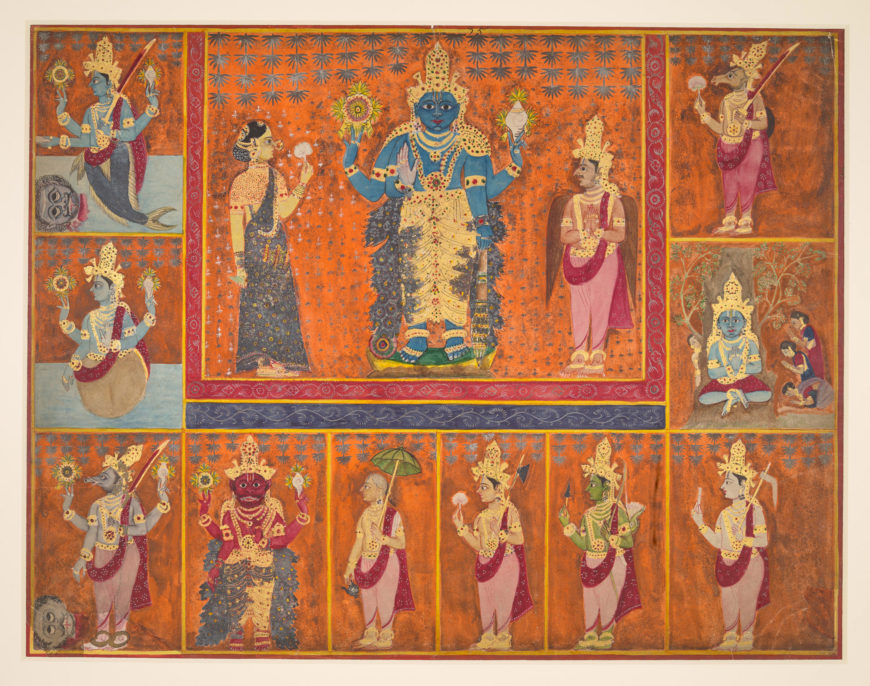Module 8: Hinduism

A watercolour painting depicting Visnu and his ten avatars in the South Indian style. South India, c.1800. Vishnu and his ten avatars, c. 1800 (The British Library)
The art piece above is a depiction of Vishnu (preserver and protector of the universe) and his ten manifestations (or avatars) dating to the beginning or the 19th century. In order from Matsya (the fish), Kurma (the tortoise), Varaha (the boar), Narasimha (the man lion), Vamanan (the dwarf), Parashurama (rama with the axe), Lord Rama (depicted in green hue), Lord Balarama (rama the strong, holding the plough), Krishna (depicted with his characteristic blue skin) and finally Kalki (with a horse's head). The multiple Gods and Goddesses of Hinduism personify various cosmic powers through fire, wind, sun, dawn, darkness, earth and so forth. Vedic deities were summoned through the sacrificial ritual. The purpose of the piece or rather the reason this piece is so important is for the sole fact that the watercolor painting shows the different manifestations in Hinduism beliefs. Some of which are half-animal half-man. A number of which holding Vishnu’s emblems, others shown with their specific weapons/ characteristics. The overall purpose for the piece is to give Hindus a sacred art piece that shows what their Gods and Goddesses would look like if they took their true form. This allows the believers to have a face to connect to the name, making a stronger understanding of what these deities physically look like. The multiple gods and goddesses are a key feature of the religion. Said painting was created for various forms of pilgrimage and prayer. The creator uses South Indian in style, thick washes of watercolor to catch the vibrancy of temples and gold paint referring to the status it holds over Hindus. The visual elements contribute to the work because you don’t normally see such a bold color pallet. I think the contrast between the blue and orange is as significant as red against orange. It gives you the sense of there being more than one to worship or believe in. Other than by forms of temple worship including personal prayer and various rituals conducted by priests, the deity may be worshipped at home also, either through personal images/ family images handed down or by way of meditation.
The British Library, "Hindu deities," in Smarthistory, March 5, 2021, accessed October 16, 2021, https://smarthistory.org/hindu-deities/.
Hello,
ReplyDeleteI really liked your analysis into the use of the colors of the art. It shows significance and meaning to the piece, and really helps to explain the overall purpose. I also liked your specification of the style of art. It would make me wonder what the same piece would look like under a different style, and if the meaning of the piece would change at all if different techniques or colors were used.
Thank you very much! This is the first piece I felt really confident writing about. The difference of styles is a crazy aspect in art.
DeleteThis piece is a very interesting piece. The colors of the people are very different. I also enjoyed how you were able to thoroughly explain and guided the reader through the piece. Is there anything that you would change about the piece? what is your favorite part?
ReplyDeleteThank you Faith, personally I would like to see where else the color pallet can go (besides all the orange) . My favorite part would have to be the amount of detail in the clothes and jewelry. Although its not perfect and symmetrical it gives you more to look at.
Delete